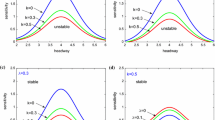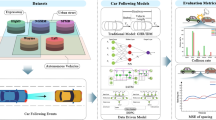Abstract
The automobile is a pervasive feature of modern technological societies despite its accompanying problems of pollution, accidents, and congestion. In the last 25 years a vast amount of literature has been published which we might classify as “traffic science.” This science has attempted to understand through modeling and data gathering the traffic processes and how to modify, optimize, and control them.
Access this chapter
Tax calculation will be finalised at checkout
Purchases are for personal use only
Preview
Unable to display preview. Download preview PDF.
Similar content being viewed by others
References
S. Bexelius, “An extended model for car-following,” Transportation Res., vol. 2, pp. 13–21, 1968.
E. A. Bender and L. P. Neuwirth, “Traffic flow: Laplace transforms,” Amer.Math. Monthly, vol. 80., pp. 417–423, 1973. Readable by students; develops some details of stability theory.
R. E. Chandler, R. Herman, and E. W. Montroll, “Traffic dynamics: Studies in car-following,” Operations Res., vol. 6, pp. 165–184, 1958. First paper on stability theory; develops asymptotic stability for a number of models; higher level than present module, but accessible to better students with some complex variable background.
D. R. Drew, Traffic Flow Theory and Control. New York: McGraw-Hill, 1968. A book on many aspects of traffic science besides car-following; lots of practical examples, many topics accessible to undergraduates.
L. C. Edie, “Car-following and steady-state theory for non-congested traffic,” Operations Res., vol. 9, no. 1, pp. 66–76, 1961.
Denos C. Gazis, “Traffic flow and control: Theory and applications,” Amer.Scientist, vol. 60, no. 4, pp. 415–424, 1972. A survey article on traffic science, like a Scientific American article.
D. C. Gazis, R. Herman, and R. B. Potts, “Car-following theory of steady state traffic flow,” Operations Res., vol. 7, no. 4, pp. 499–505, 1959. Very readable; uses only algebra and simple integration.
D. C. Gazis, R. Herman and R. W. Rothery, “Nonlinear follow-the-leader models of traffic flow,” Operations Res., vol. 9, no. 4, pp. 545–567, 1961.
H. Greenberg, “An analysis of traffic flow,” Operations Res., vol. 7, no. 1, pp. 79–85, 1959.
R. Herman, et al., “Traffic dynamics: Analysis of stability in car-following,” Operations Res., vol. 7, pp. 86–106, 1959. The definitive article on stability theory: not accessible to average undergraduates.
Robert Herman and R. B. Potts, Single-Lane Traffic Theory and Experiment, Theory of Traffic Flow. Amsterdam: Elsevier, 1961, pp. 120–146. Very readable summary of car-following without too many technical details; good source of experimental results.
G. Lee, “A generalization of linear car-following,” Operations Res., vol. 14, no. 4, pp. 595–606, 1966.
G. F. Newell, “Theories of instability in dense highway traffic,” J. Operations Res. of Japan, vol. 5, pp. 9–54, 1962.
L. A. Pipes, “An operational analysis of traffic dynamics,” J. Appl. Phys. vol. 24, no. 3, pp. 274–281, 1953. The original paper on car-following; easily read by those with background to read this module.
E. Tuck, “Stability of following in two dimensions,” Operations Res., vol. 9, no. 4, pp. 479–495, 1961.
W. E. Wilhelm and J. W. Schmidt, “Review of car-following theory,” Transportation Engineering J. of ASCE, vol. 99, no. TE4, pp. 923–931, 1973. A bibliographic survey; easily read by students.
Author information
Authors and Affiliations
Editor information
Editors and Affiliations
Rights and permissions
Copyright information
© 1983 Springer-Verlag New York Inc.
About this chapter
Cite this chapter
Baker, R.L. (1983). Car-Following Models. In: Braun, M., Coleman, C.S., Drew, D.A. (eds) Differential Equation Models. Modules in Applied Mathematics. Springer, New York, NY. https://doi.org/10.1007/978-1-4612-5427-0_12
Download citation
DOI: https://doi.org/10.1007/978-1-4612-5427-0_12
Publisher Name: Springer, New York, NY
Print ISBN: 978-1-4612-5429-4
Online ISBN: 978-1-4612-5427-0
eBook Packages: Springer Book Archive




